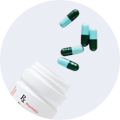Based on the search results, here are some specific organic chemistry products and their applications across various industries:
1. Petrochemicals
-
Ethylene: Used as the starting material for polyethylene, the most widely used plastic globally. Polyethylene is found in packaging materials, household goods, and toys.
-
Propylene: A key component for producing polypropylene, a versatile thermoplastic polymer used in automotive parts, textiles, and consumer products.
-
Benzene and Toluene: Central to the production of styrene (for polystyrene plastics) and phenol (for polycarbonate plastics and epoxy resins).
2. Pharmaceuticals
-
Aspirin (Acetylsalicylic Acid): A widely used drug synthesized from salicylic acid and acetic anhydride.
-
Antibiotics: Compounds like penicillin and streptomycin, which are derived from natural sources but often modified to enhance efficacy and safety.
-
Active Pharmaceutical Ingredients (APIs): Organic compounds that are the main active components of medications, synthesized through complex organic reactions.
3. Agrochemicals
-
Glyphosate and Atrazine: Herbicides used to control weed growth, ensuring crops receive adequate nutrients and water.
-
Organochlorines, Organophosphates, and Carbamates: Pesticides that protect crops from insects and other harmful organisms.
-
Urea and Ammonium Nitrate: Organic nitrogen compounds used as fertilizers to enhance plant growth.
4. Polymers and Materials
-
Polyvinyl Chloride (PVC): Used in construction materials such as pipes, due to its durability and resistance to corrosion.
-
Polyethylene Terephthalate (PET): Commonly used in packaging, such as plastic bottles and containers.
-
Kevlar and Teflon: Advanced polymers with high strength and resistance to heat and chemicals, used in aerospace, military, and industrial applications.
5. Dyes and Pigments
-
Azo Dyes, Anthraquinone Dyes, and Phthalocyanine Pigments: Used to impart various hues in textiles, paints, plastics, and inks.
-
Conductive Polymers: Used in organic light-emitting diodes (OLEDs) for display technologies.
6. Solvents
-
Acetone, Ethanol, and Toluene: Essential in industrial processes for dissolving, extracting, and purifying various substances.
-
Supercritical Carbon Dioxide and Ionic Liquids: Environmentally friendly solvents gaining traction in industry.
7. Flavors and Fragrances
-
Essential Oils, Esters, Aldehydes, and Ketones: Used to create appealing scents and tastes in food, beverages, cosmetics, and personal care products.
-
Salicylic Acid: Used in acne treatments for its exfoliating properties.
8. Cosmetics and Personal Care
-
Glycerin (C3H8O3): Acts as a humectant, retaining moisture in creams and lotions.
-
Jojoba Oil (C20H40O) and Coconut Oil (C12H24O): Used as emollients to soften and soothe the skin.
-
Parabens: Organic preservatives that prevent microbial growth and extend product shelf life.
9. Food and Beverage
-
Citric Acid (C6H8O7): Used as a flavor enhancer and natural preservative.
-
Flavoring Agents: Organic compounds that contribute to the taste of food and beverages.
10. Environmental Applications
-
Biodegradable Plastics: Derived from renewable resources like corn starch or cellulose, reducing environmental impact.
-
Eco-friendly Detergents: Contain organic compounds that are more environmentally friendly and biodegradable.
These examples highlight the diverse range of organic chemistry products and their critical roles in various industries. The versatility and functionality of organic compounds make them essential for both industrial processes and everyday products.




